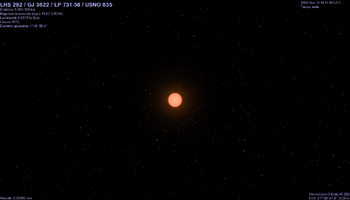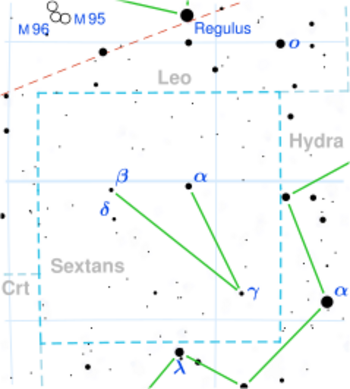Astronomy:LHS 292
From HandWiki
Short description: Red dwarf star in the constellation Sextans
Coordinates: ![]() 10h 48m 12.6s, −11° 20′ 14″
10h 48m 12.6s, −11° 20′ 14″
| Observation data Equinox J2000.0]] (ICRS) | |
|---|---|
| Constellation | Sextans |
| Right ascension | 10h 48m 12.6s[1] |
| Declination | −11° 20′ 14″[1] |
| Apparent magnitude (V) | 15.73[1] |
| Characteristics | |
| Spectral type | M6.5 V |
| Apparent magnitude (J) | 8.9[2] |
| B−V color index | 2.10 |
| Variable type | Flare star |
| Astrometry | |
| Proper motion (μ) | RA: 579.019±0.066[3] mas/yr Dec.: −1530.076±0.058[3] mas/yr |
| Parallax (π) | 219.3302 ± 0.0602[3] mas |
| Distance | 14.871 ± 0.004 ly (4.559 ± 0.001 pc) |
| Absolute magnitude (MV) | 17.45[1] |
| Details | |
| Mass | 0.08[1] M☉ |
| Radius | 0.11[4] R☉ |
| Luminosity | 0.00069[5] L☉ |
| Temperature | 2650-2900[5] K |
| Metallicity [Fe/H] | -0.41 dex |
| Other designations | |
LP 731-58, GJ 3622, GCTP 2516.02 | |
| Database references | |
| SIMBAD | data |
Location of LHS 292 in the constellation Sextans | |
LHS 292 is a red dwarf in the constellation Sextans. It is far too faint to be seen with the unaided eye and requires a large amateur telescope to be seen visually. It lies relatively close to the Solar System at a distance of about 14.9 light years. It is a flare star, which means it can suddenly increase in brightness for short periods of time.
It has the space velocity components [U, V, W] = [28, −16, −14] km/s.[6]
See also
References
- ↑ Jump up to: 1.0 1.1 1.2 1.3 1.4 "The One Hundred Nearest Star Systems". Georgia State University. 2007-09-17. http://www.astro.gsu.edu/RECONS/TOP100.posted.htm.
- ↑ "LHS 292". SIMBAD Astronomical Database. http://simbad.u-strasbg.fr/simbad/sim-id?Ident=LHS+292.
- ↑ Jump up to: 3.0 3.1 3.2 Brown, A. G. A. (2021). "Gaia Early Data Release 3: Summary of the contents and survey properties". Astronomy & Astrophysics 649: A1. doi:10.1051/0004-6361/202039657. Bibcode: 2021A&A...649A...1G. Gaia EDR3 record for this source at VizieR.
- ↑ J. Morin (October 2010). "Large-scale magnetic topologies of late M dwarfs". Monthly Notices of the Royal Astronomical Society 407 (4): 2269–2286. doi:10.1111/j.1365-2966.2010.17101.x. Bibcode: 2010MNRAS.407.2269M.
- ↑ Jump up to: 5.0 5.1 Golimowski (2004). "L' and M' Photometry of Ultracool Dwarfs". The Astrophysical Journal 127 (6): 3516–3536. doi:10.1086/420709. Bibcode: 2004AJ....127.3516G.
- ↑ Reiners, Ansgar; Basri, Gibor (November 2009). "A Volume-Limited Sample of 63 M7-M9.5 Dwarfs. I. Space Motion, Kinematic Age, and Lithium". The Astrophysical Journal 705 (2): 1416–1424. doi:10.1088/0004-637X/705/2/1416. Bibcode: 2009ApJ...705.1416R.
Notes
External links
 |



